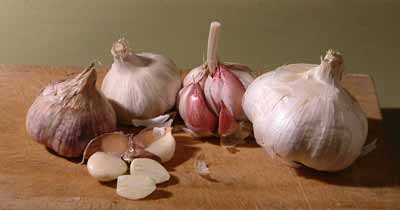Garlic is thought to have originated in the mountains of Afghanistan, Uzbekistan and Tajikstan. Here the climate is arid with long, hot days. This informs garlic's growing requirements of full sun and loose, free-draining soil, particularly the soft-necked varieties.
There are two main groups of garlic, soft neck (Allium sativum var sativum) and hard neck (Allium sativum var ophioscordum).
Young garlic is white with a soft, juicy covering and tiny cloves. In this form, the bulbs are best roasted whole. As the bulbs dry the cloves increase in size, taking the moisture from the succulent covering. Mature bulbs can be recognised by the papery nature of the skin. Avoid cloves which have shrunk a little inside their skins. They should be hard, plump and fill their skins. If you have sprouts growing from your bulbs you will find that the flesh of the garlic is quite sour and strong. However, the shoot itself can be lifted out and used in soups, risottos or salads.
Garlic loses some of the violence of its flavour when it is cooked. Garlic is a relative of the lily, the onion and the leek. Len Deighton suggests that you do not flatten cloves of garlic with the side of a knife, as this will scatter particles of garlic onto your clothes, the smell of which will be impossible to remove.
In countries where garlic is commonly used in cooking, any mention in the title of the dish is likely to mean especially pronounced use.
The best way to store garlic is to plait (US: braid) the tops together – this applies to soft neck, not hard neck garlic - or put them in a string bag and hang them in a cool dry spot, preferably with a cool draught.Soft neck garlic stores more easily than hard neck and is the type most readily available commercially. The ideal temperature is 32-55F (0-12C). In this condition, it might last for as long as 6 months but there are no guarantees and you may find that they have turned to dust. Alys Flower says that the most hard neck varieties store very poorly, particularly Rocambole types, but Porcelain types store very well for long periods. She recommends Arno and Christo varieties as having good yields and flavour and lovely white bulbs, but her favourite is Music.
If you would like to grow your own, separate a head of garlic between October and February and plant it with the pointed end just below the surface of the earth. This can be done in pots. Garlic planted in September likes to have a cool period with temperatures below 10ºC. In early summer the new heads can be lifted and then dried in the sun or in a well ventilated, cool space. These will keep until about December. The best spring-planting variety is Cristo. Solent and Lautrec Wight also do well planted in Spring.
